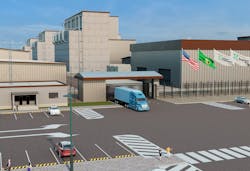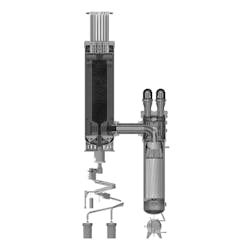Positive Cascade Effect: Black & Veatch Director Marvels at Pace of SMR Advance
Kristen Braun has appreciated the positives of nuclear energy since her childhood.
For one thing the industry fed her family. Her father, Jerry Brown, spent his career as an engineer and project manager on various reactor projects, so she grew up with dad talking about nuclear energy as a vital part of the American power generation mix. Those were the days.
Then Kristen herself grew up and graduated into key roles on the engineering, procurement and construction (EPC) side of the nuclear generation sector with companies such as Bechtel.
Nuclear wasn’t as appreciated environmentally or economically in recent decades, as the U.S. reduced its new builds to only a few plants and others were marked for retirement due to costs vs. gas-fired and renewable power. The era of No Nukes, China Syndrome, Chernobyl and Fukushima. Much of society discarded the positives and walked away from support of nuclear fission to produce electricity.
Nuclear testament to energy demand from AI and data centers
The industry seemed abandoned and on the brink of irrelevance (although that was never really true). For a time, Kristen took her career into other types of construction projects and even wondered if she would ever return her attention to fission.
Now she’s back at it as associate vice president and nuclear business line director for EPC firm Black & Veatch, helping lead what is promising to be a revival in nuclear energy nationwide as the U.S. seeks ample and sustainable power for artificial intelligence, data centers, industrial and transportation electrification.
“This is a testament to all the changes” happening in the economy and technology, Braun said in an exclusive interview with EnergyTech. “The need for carbon-free baseload generation—that is hands down one of the biggest factors helping nuclear to the precipice of a great moment.”
Some call it the “nuclear renaissance,” and some call it common sense, as nuclear power can offer a solution at the intersections of resiliency and sustainability given its high capacity factor and lack of carbon emissions. The potential is driving Big Tech and digital infrastructure firms to seek out both conventional and future small modular reactor (SMR) nuclear plants to both decarbonize the grid and deliver resource adequacy at a time when AI and cloud-based computing load may drive demand up by hundreds of gigawatts.
Braun’s own company is working at the center of this movement. West coast-based public power agency Energy Northwest is collaborating with a joint venture featuring Black & Veatch on what may prove to be the first SMR power generation complex built in Washington state.
Cascade Advanced Energy Facility and Amazon
Two weeks after Amazon and Energy Northwest unveiled initial plans for the 320-MW Cascade Advanced Energy Facility north of Richland, the public power agency selected the Cascade Nuclear Partners EPC venture to guide the design and construction of the project which will house the first four of 12 planned X-energy Xe-100 SMRs. Cascade Nuclear Partners is jointly comprised of Black & Veatch, Kiewit Nuclear Solutions and Aecon.
“Energy Northwest is using a progressive design build model, with several years of planning, then financial investment decision before moving to construction,” Braun noted. “By 2035 I expect several SMR units online in North America.”
Yes, that’s 10 years away and critics are skeptical about SMRs and the nuclear revival because of cost issues and safety concerns around reactors. Proponents, on the other hand, counter that nuclear plants have long operational lives (some licensed for 80 years now) and, once again, offer unmatched capacity factors with carbon-free generation same as renewables.
“It doesn’t matter if the wind isn’t blowing or the sun isn’t shining, nuclear is still producing baseload power,” Braun pointed out. “Hyperscalers have energy demands and carbon reduction goals, so it’s a great match, they have the need, and they have the funding and financing to support it.”
Indeed, Amazon is financially supporting the X-energy project, while Meta, Microsoft, Oracle and Google have signed long-term power deals with other nuclear projects, both conventional restarts and SMR new-builds.
X-energy itself is working on another project to deliver Xe-100 SMRs for a Dow chemical industrial factory in south Texas. As with that project on the Gulf Coast, the Cascade Advanced Energy Facility’s reactor design for Amazon in Washington will also undergo U.S. Nuclear Regulatory Agency approval processes.
They don't exist yet, but small reactors bound to happen big
Haters may hate, but proponents and other forecasters are confident that nuclear will shake it off and grow in proportion to the coming wave of digital infrastructure demand. A new report from ABI Research anticipates that 262 SMRs will be deploying globally by 2040 to deliver close to 42 GW of new generation.
“SMRs offer a wide range of benefits,” said Dominique Bonte, Vice President, End Markets and Verticals at ABI Research, in a statement. “Their inherent upgradeability, flexibility, scalability, and rapid deployability make them suitable for a wider range of more granular, grid-based, and on-site deployment scenarios, such as data centers and industrial sites.”
Now Black & Veatch’s Braun, like ABI, knows that the momentum won’t really materialize until at least 2030. The regulatory and financial timelines are deliberate, despite rising affirmation by the Trump Administration through four Executive Orders supporting SMR and nuclear energy development.
“It’s a very exciting time. For the first time in my 30 years in our industry,” Braun admitted. “We have unprecedented support.”
Some of the attractions to SMR technology are in the concept of modularity to streamline design and construction processes to reduce costs, as well as passive safety features using natural physics and new, meltdown-resistant fuels such as TRISO.
“It’s definitely an improvement from past designs, using the natural physics to help with safety,” Braun said. “Natural circulation, gravity-driven coolant; they don’t need external forces to make them work. Physics is going to make them work.”
Like her father, Braun is a big believer in the value of nuclear energy to help America achieve both power capacity and environmental goals. She’s also seen the evolution of EPC processes made more efficient by data and digital tools.
“We really don’t know where AI is going to take us,” Braun noted, but “it’s a combination of both digital and physical changes in technology. When you look at the physical word and some of the tools we use, those have expanded a lot. You’re using technology to help ensure accurate placement during construction.”
These learnings never stop and will be incorporated over time into SMR design and construction. Once physical work begins at the Cascade Advanced Energy Facility, the teams with Kiewit, Black & Veatch and Aecon will focus on the first four units and quickly deploy those learnings to build more and more.
“We build it once and then we build it over and over and over again and get smarter over time,” she said. “We’re contracted to build the first four of the X-energy units, but the plan is to build up to 12.”
Ten years ago, the nuclear industry was in free fall. Germany, France and Japan were intent on closing fleets, while the U.S. was shutting down plants and turning them over to decommissioning specialists. Nuclear was too expensive to keep going in an era of flat load growth.
What a difference a decade makes. The rise of an Industrial Compute Age requires new solutions, or at least the renaissance of a longtime technology done in a new and more streamlined way.
The future has a way of making past predictions look silly at best. As Braun pointed out, if someone had said the U.S. would be reopening Three Mile Island Unit 1 a few years ago someone else easily might have called it delusional.
“It is generational,” Braun said of this point in history for her chosen vocation in nuclear development. And she should know because the industry is like family to her.
About the Author
Rod Walton, EnergyTech Managing Editor
Managing Editor
For EnergyTech editorial inquiries, please contact Managing Editor Rod Walton at [email protected].
Rod Walton has spent 17 years covering the energy industry as a newspaper and trade journalist. He formerly was energy writer and business editor at the Tulsa World. Later, he spent six years covering the electricity power sector for Pennwell and Clarion Events. He joined Endeavor and EnergyTech in November 2021.
Walton earned his Bachelors degree in journalism from the University of Oklahoma. His career stops include the Moore American, Bartlesville Examiner-Enterprise, Wagoner Tribune and Tulsa World.
EnergyTech is focused on the mission critical and large-scale energy users and their sustainability and resiliency goals. These include the commercial and industrial sectors, as well as the military, universities, data centers and microgrids. The C&I sectors together account for close to 30 percent of greenhouse gas emissions in the U.S.
He was named Managing Editor for Microgrid Knowledge and EnergyTech starting July 1, 2023
Many large-scale energy users such as Fortune 500 companies, and mission-critical users such as military bases, universities, healthcare facilities, public safety and data centers, shifting their energy priorities to reach net-zero carbon goals within the coming decades. These include plans for renewable energy power purchase agreements, but also on-site resiliency projects such as microgrids, combined heat and power, rooftop solar, energy storage, digitalization and building efficiency upgrades.



